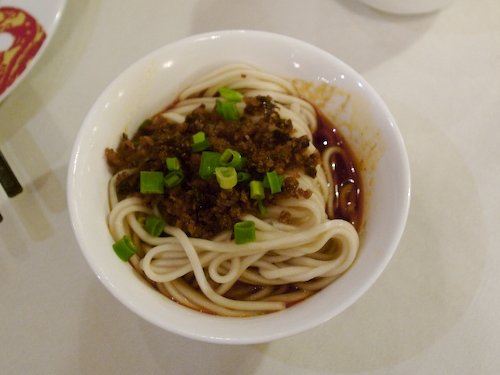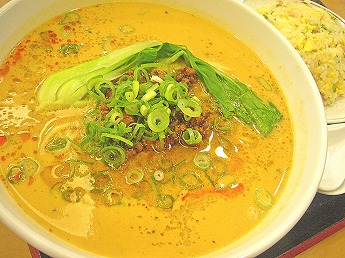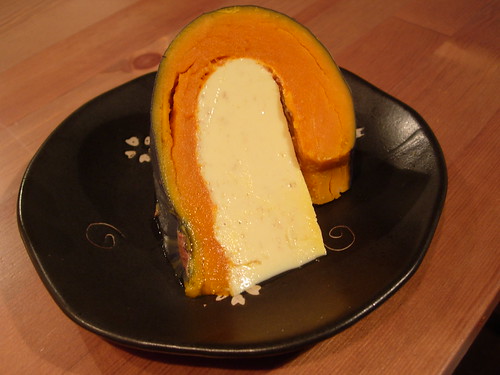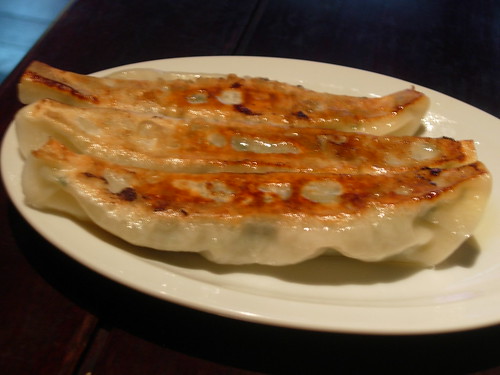Kichisen was recommended to us by the Kyoto Foodies as the best traditional-style kaiseki in Kyoto. We were more than a little worried about the reservation, since we were calling just a couple of days in advance for dinner on one of Japan’s top date nights, at an amazingly celebrated restaurant whose chef beat Morimoto Masaharu on the original Japanese Iron Chef program — no mean feat, especially considering he won unanimously against Morimoto, who almost never lost. In the event, we called, and they said no problem, see you then.
Kichisen, known also as Kisen, is in Shimogamo, which is a triangular area of northern Kyoto defined by the two big streams that join to form the Kamogawa river. The restaurant is on the southwest corner of Shimogamo Shrine, an old (technically older than Kyoto itself, in fact) and picturesque shrine with lots of grounds that you can see from well down the Kamogawa. The doorway could be anything old-fashioned, really: a big house, a ryokan, anything. But it’s a restaurant.
We go in, slip off our shoes, and are led immediately to the right, into a little room with a bar and a stone floor. We’re given straw slippers to wear from the door to the bar, and I have some trouble putting them on because my feet are big and besides I’m wearing socks, the latter making it tricky to get the sandal thong between my toes. But the distance is about six feet, so it hardly matters. A burly man with a widow’s peak, wearing a white gi top — like a martial arts uniform — took my coat and folded it neatly on the shelf behind us. He also gave my wife a blanket to keep her legs warm, which is a common routine at nice places in the winter. We sat.
For Openers
The burly man went behind the bar and the various other attendants and such vanished. It was just us and him. After handing us hot towels, he promptly gave us these little dishes filled with hot dashi sprinkled with toasted rice (genmai, like in genmai-cha). Pleasant, warming, and stimulating the appetite.

He also checked that we spoke Japanese — me, no, but my wife certainly does — and then asked whether there was anything we don’t like to eat. Nope, we eat everything, no worries. (I wasn’t going to mention the one Japanese favorite I almost always dislike, which is boiled or simmered daikon, because I think he would have been well within his rights to chuck me out. It would be sort of like going to a high-end Italian place and saying you can’t stand garlic, cheese, tomatoes, or pasta. Not that daikon dominates Japanese food, any more than that little list dominates good Italian cooking, but it’s a constant presence. More about this later.)
On to the first course, presented in these cute little dishes, on top of this piece of calligraphy. He explained that we’re leaving the year of the Rat and entering that of the Cow, so in late December we get both. The calligraphy was, as I understand it, a poem with very heavy allusions to Sen no Rikyu, the inventor of tea ceremony and thus the ultimate forefather of kaiseki.
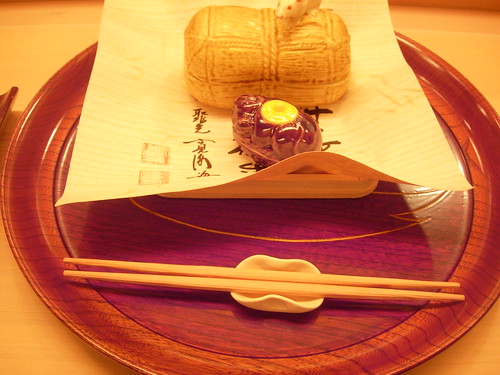
Inside the dishes, a range of things, not all of which we can identify. From left, clockwise, in the top container: Sliced duck squares sandwiched around a thin slice of sweet simmered something, possibly some kind of sweet turnip or maybe fruit. A cube of some kind of tofu cake, I think with gingko nuts in it. Broccolini simmered in what I believe was Tosa-zu (Tosa-style vinegar), seasoned with ground toasted sesame. A teeny-tiny piece of a stick of super-mild pickled ginger. In the very front right, where you can't see them, were two little long-simmered whole fish, to be eaten whole. In the lower dish were two things: yellow stuff and green stuff. My wife thinks the yellow stuff might have been prepared persimmon of some kind; I think she's wrong, but I can't offer any better guesses. The green stuff... no idea. Maybe some sort of bamboo shoot, but that's out of season, so who knows?

On With The Show
We continued with a clear soup: dashi, shiitake cap, teeny baby bok choy, and a cube made primarily of Ise-ebi (spiny lobster), garnished (aromatized) with julienned yuzu zest. The chef instructed us to taste the dashi first by itself, then drop the yuzu in the front and taste again, and then eat the things in the soup in between sips of broth. That business with the yuzu creates the effect called “aromatized”: the dashi remains dashi (and very good dashi at that!), but the yuzu adds an intense acid-floral aroma. My sense was that these two strongly different flavors are supposed to create a sort of frame for the things in the soup, but I could well be misunderstanding. In any case, it was nice finally to have a classic suimono clear soup made by somebody who’s into it, and I must say that it's lovely when done right.

Next up, otsukuri, which is the local term for what Tokyo-ites call sashimi. It didn’t come up, but it was becoming clear that if we had asked the chef, he would have told us that the proper word is “otsukuri,” although of course a lot of hicks from polluted holes like Tokyo use silly terms like “sashimi.” He is, as you’ll have figured out, pretty proud of Kyoto — “best food in the world.” He also doesn’t like food outside Japan, and told us about how he ate uni (sea urchin) in New York; his host apparently said it was very good, so he was polite, but actually he thought it was old and nasty. Tokyo, he doesn't like much either -- the air is foul and you can't breathe. The only place he seemed to have anything nice to say (other than Kyoto) was Finland, where he liked the fact that the air is clean. Back to food, he also didn’t like the bread in France, but we had to disagree (equally politely) about that one! In any event, the uni question came up because of the otsukuri he served.
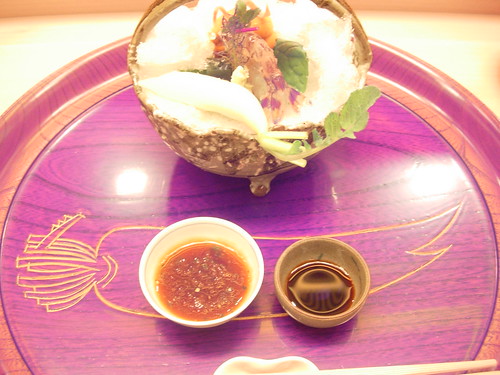
The photo is too bright because of the shaved ice, I’m afraid, but you can still see what we ate. Dead-center is a raw shrimp, behind which is a pile of uni. Mmmm, I love uni. In the front is a baby daikon, and then the whole thing is garnished with little edible nibbles. He gave us some sheets of toasted nori seaweed and instructed us to wrap the uni in it, then dip lightly in soy. The shrimp and daikon got the ponzu with grated daikon and so on. Personally, I’m not a fan of raw shrimp, and now I know for sure that I just don’t like it all that much: if I didn’t like it at Kichisen, I don’t like it! But the uni was just right: seafood butter with a little texture, and with the dab of soy and the crunchy nori it was spectacular.
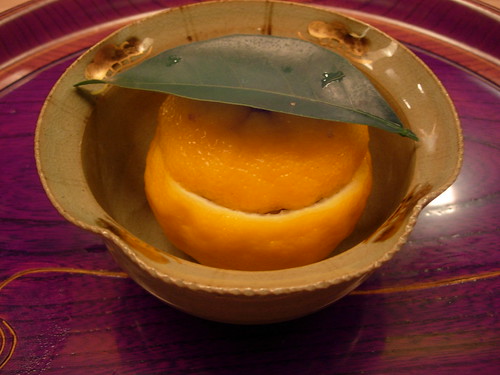
Then a hollowed-out yuzu steamed with rice, little dried berries, and tiny fluted potatoes. He encouraged me to photograph it both as presented (with the lid) and opened up. We didn’t quite figure out what the berries were. I thought they might be kuromame, black beans, but he said they were berries and gave the name — which my wife didn’t happen to know off the top of her head. It’s a rather specialized vocabulary, and probably he was using a regional dialect term anyway. They had a very mild taste and a little bit of crunch. The potatoes didn’t taste like all that much, really, but the rice and yuzu combination was warming and friendly after the icy otsukuri. Clearly part of the idea here is an alternation between snow and warmth, giving you the best things of December.

Climax
For me, the climactic moment — the best dish of all — was this cup. Inside was fugu, the much-discussed poison blowfish, covered with chopped thin negi (asatsuki) and a sauce of ponzu and other things I couldn’t quite place. I’d had things flavored with fugu before, but here we really got to taste what it’s like: mild, creamy, and rich. (My wife thinks that this might not have just been regular flesh, but obviously it can't be the liver, as the fugu liver is where the tetrodotoxin is, and if you eat more than a trace amount, you die. I think it can't have been organs of any kind, as I think then you'd have had some trace tetrodotoxin and gotten numb lips, which some fugu crazies enjoy.) In any event, it was extraordinary to me. The texture was reminiscent of uni, but firmer. The flavor was very sweet as fish go, and yet ocean brine-y. The only way I can explain it, I guess, is that this fugu was for me everything otsukuri and sushi really ought to be, but never is.
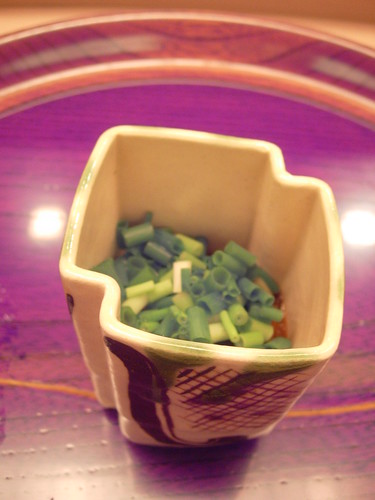
Back to the snows: crab legs split and served in shaved ice. The little dish in front contained the “mustard,” what the Japanese call the miso, i.e. the liver and fat of the crab. It was mixed with a little soy, dashi, ginger, and a little bit of some kind of citrus juice — I think sudachi, but I wouldn’t swear to it. We discussed this with him, while we drank off the dish — it’s for dipping, but it’s too good to let it go to waste. The usual way to serve cold steamed crab in the West is with something like a mayonnaise, which is nice, but my wife and I agreed that you really need something more acid to cut the richness. This combination was lovely: the richness was from the crab, in the form of its mustard; the acid comes from the citrus; and the whole thing is deepened with the Japanese standards of dashi and a very small amount of soy. The chef mentioned that the crab was from the Japan Sea, not Hokkaido, and that the ginger is Japanese, not imported, both of which make it enormously more expensive; his point wasn't that it was expensive, I think, but that he insists on these ingredients because (a) they're local, and (b) they taste better. [Admittedly, I think he probably thinks "local" and "tastes better" pretty much imply one another, but he wouldn't serve local ingredients that didn't taste good, whatever they cost.]
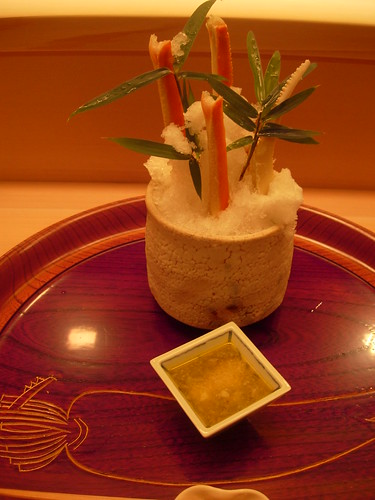
Back home, I will have to try something like this with lobster or softshell crab. I’ll pass on the soy and dashi, which don’t speak to me the way they do for the Japanese. But instead of just drawn butter and lemon, or mayonnaise, why not use the mustard or tomalley, a small squeeze of seasonal citrus, and then a teeny drop of white wine? Maybe just a whisper of finely-minced shallot too.
Now the next thing was much, much better than I think it had any right to be. Steamed or perhaps poached turnip on top of a little pile of amadai (tilefish, or Japanese branquillo), with grated daikon and minced negi, some gingko nuts, a little ball of mild wasabi on the top, all in a puddle of warm jellied dashi aromatized with toasted rice. Described that way, I would have assumed I’d hate this. But first of all it was made so well, and the flavors balanced so perfectly, that you really couldn’t dislike it. And coming after the snowy crab, once again the little dish of warmth was delightful. I would not want this dish by itself, though I wouldn’t complain, but in this context it was wonderful.

Next up, soba and then tempura. The soba came as you see it: a mound on a little wooden dish, in a basket lined with leaves, with a classic dipping sauce... or so we assumed. We were told that when we’d finished the soba, we’d have tempura with the same sauce. Now I will say that this soba must have been pure buckwheat flour, or nearly so, and was firmer and more flavorful than soba normally is. Other than that, it was mostly a sort of palate-cleanser: going from the squodgy turnip and amadai straight to rich tempura would be problematic.

Then came a basket of freshly-fried tempura, and we picked out equal portions, as you see here. Two shrimp, two quartered shiitake caps, a short stalk of pickled ginger, and a bit of gobo (burdock) stalk. I am not normally a fan of gobo, but this was terrific. And the shrimp were moist and creamy in a way that tempura, even good tempura, normally isn’t. All in all, the best tempura I’ve ever had, though I can’t say I’ve had all that much good stuff.

I was very proud of myself here. As we ate, I kept thinking that there was something odd about the sauce. On the one hand, this was your basic tentsuyu: mirin, dashi, and soy, with grated daikon mixed in. But it was slightly, yet distinctly, spicy. I asked what it was, and the chef said it was daikon. I insisted: what’s making is it spicy? He seemed quite pleased, and told me that it’s not normal daikon but rather karashi-daikon, which is indeed slightly spicy. He also called one of the other chefs in the kitchen to bring him a karashi-daikon to show me. It looked like a small kabu turnip: round, white, and about the size of a small baby’s fist. I think he was pleased because here was a foreigner who could identify the difference between types of daikon even when mixed into tentsuyu. I was, as I say, pretty proud of myself. (Thing is, karashi-daikon I consider a major improvement on regular daikon, having the sweetness of daikon, the sharpness of red radish, and none of that old turnip flavor I associate with daikon and which is why I dislike boiled daikon. I’m going to go looking for karashi-daikon at Nishiki market.)
The last major course was rice and pickles. The pickles were the round "thousand-slice" daikon pickles (senmaizuke) that are a Kyoto winter specialty, plus some preparation of lotus root that I couldn’t place. The rice is apparently this super-fancy rice grown just for him, and he asked if we could tell that it’s so good. I answered, honestly, that I could tell either that it’s extremely good rice or very well made, but beyond that I’m lost; since this rice fitted both descriptions, I’m afraid its spectacular qualities were largely wasted on me. He seemed mollified, though.
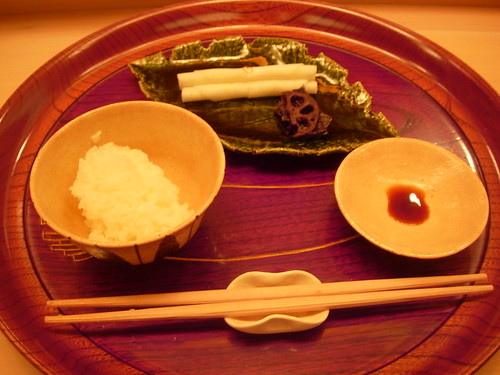
Closing Acts
For dessert, this beautiful dish. It’s a California citrus of some kind, which I still can’t place: it’s like a very tart orange with a green peel, but I don’t think it was actually underripe. Perhaps a green grapefruit? Anyway, he’d hollowed it out and made a medium-stiff jelly with the juice, which set back in the shell — no mean trick, this. Over the top, a fine web of lightly-cooked caramel, garnished with a shaving of caramelized peel. The sauce was, I think, dark-caramelized sugar, citrus juice, and just enough water (I’d guess) to keep it fairly thin. You put the web on the jelly, pour sauce over the top, and then dig in with a spoon.

Of course, because this was garnished with snow again, and was quite bitter-sour, we finished it up thinking, “hmm, kind of cold and bitter here.” So on came the second dessert: zensai, as they call it here. Red beans and mochi simmering in a little cup.
It came like this, with a lid on, and under it you can see the actual dessert.
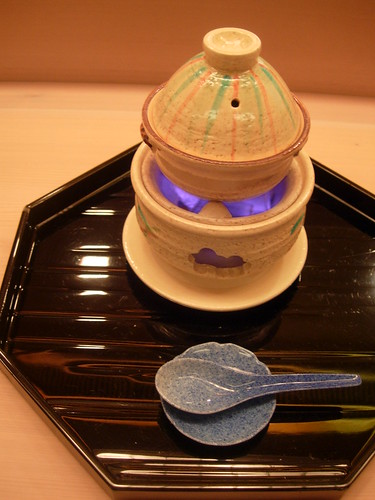
In the bottom was a little mound of hot charcoal, which kept the mixture bubbling and very close to too hot to eat. My wife actually burned her tongue a bit, but she’s kind of a klutz that way.
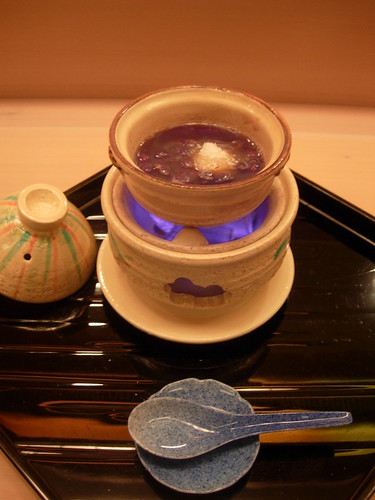
I didn’t get photographs here, but we had another demonstration of the brilliance of kaiseki at its best. We’d finished the citrus thinking we wanted something hot and sweet, and we got it — but it was too hot, and too sweet. So what then? Well, then came bowls with a small amount of macha, powdered green tea, which is extremely bitter because you’re actually drinking the leaves as well as their infusion. Wonderful... but now kind of bitter in the mouth, albeit warm? Oh, yes, then came just a little mild tea to finish up. So each time you finished one thing, it took you just a bit too far in one direction, and then you got something that met this need but pushed a little too far in another direction, and so on. Fantastic, honestly.
The Chef's Table
While we drank our final tea, the chef chatted with us. As we’d long since realized, this burly man in the white gi was the chef, Tanigawa Yoshimi. The guy who beat Morimoto hollow on Iron Chef. The guy who seems to be one of the architects of the kyo-ryori movement against the over-elegance of kaiseki as such. (As I understand it, the point is that Tanigawa thinks much of kaiseki has lost touch with the rustic elegance that was so central for Sen no Rikyu’s chanoyu; it’s become sophisticated in a more urban, courtly style. His kyo-ryori emphasizes a greater simplicity, but as you can see, that’s not “down-home cooking” or anything like that, just a renovation of the aesthetic.) In any event, the guy who mopped my wife’s dish when she slopped on it (told you she’s a bit of a klutz!) was one of the most celebrated chefs in this whole cuisine.
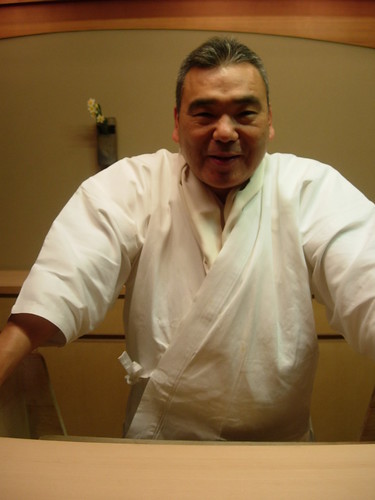
You may recall that Chef Murata served us most of our food at Roan Kikunoi, and now Chef Tanigawa served us at Kichisen. This isn’t because we’re special: that’s how kaiseki (or kyo-ryori) works. Murata was less attentive, because he had three parties at the bar; Tanigawa was with us almost the entire time, though he didn’t stand over us, because we were alone at the bar.
By way of contrast, my wife gave me this link to an article in the New York Times. It's about a new fad, dining at the "chef's table." The idea is that when you go to some place like Craft or Blue Ginger or wherever, a place where the chef is more or less a celebrity (as Tom Colicchio and Ming Tsai are, at these restaurants), they actually cook your food. That's right, if you make a reservation weeks and weeks in advance, and pay extra, you too can have the special exclusive experience of having the chef of a fancy restaurant actually cook. Isn't that grand? The NYT reviewer seems underwhelmed by the cooking, but he doesn't criticize the concept.
Thing is, this is absolutely normal in kaiseki. If you go to Tanigawa's restaurant, or Murata's, you know that they're cooking. Where else would they be? Not that Tanigawa made every part of every dish we ate -- far from it. But every bit was done under his watchful eye, finished by his hands or with him standing over (and possibly yelling at) the guy doing the finishing, and served to us from his hands (actually two things were served by apprentices, but Tanigawa was a constant presence). And this isn't because we're special: that's how this cuisine is done.
In this situation, Chef Tanigawa really could have gotten away with murder: he could have tried to impress us with his wonderfulness, or awe us, or whatever. But that's contrary to the aesthetics he believes in. He wants us to eat and enjoy, and he works very hard indeed to make that happen -- but the hard part of that work is hidden, so as not to disturb us. He wants to entertain us, but he makes minimal use of his celebrity to do it. He did mention the Iron Chef thing, but actually the point was that it gave him an opportunity to ensure that we went home with a copy of the DVD of the show. He also put in a box of his own chirimen, in this case chewy little teeny semi-dry fish seasoned strongly with sansho. Why? Well, you want your guests to leave without that feeling that it's all just over, the sort of post-dining letdown, so you give them some gifties. The fact that he's a culinary celebrity helps him to do this, but it's not something he made a big deal about. My wife asked him, "What was doing Iron Chef like?" His complete response: "Shindoi" (tiring). As to Murata, whose book is apparently something of a sensation among Western cooks lately, and is on TV a lot, and so on -- he just never mentioned any of this, nor in fact made it clear who he was.
There's a kind of high elegance to that. You're being served dinner by a famous celebrity chef, but he's too busy focusing on you and your meal to make a fuss about himself. You're what matters, not him. Isn't that how it should be?
Conclusion
My conclusion? I really like kaiseki, kyo-ryori, whatever. It’s brilliant, elegant, sophisticated, and just beautifully constructed to produce a fabulous dining experience. Perhaps most importantly, it is completely unpretentious. No arrogance, superiority, or whatever. He just did what he did, and wanted us to enjoy it as best we could, and his explanations and so forth were clearly aimed at helping us get more out of it. But I don’t think he thought we needed helping along: he’d have done the same thing with any diners who seemed interested, pitched to the appropriate level.
So, after perhaps the best meal of my life, I find myself wondering: could kaiseki be done outside Japan? Arguably it doesn’t really exist outside the Kyoto area, but that’s not what I mean. I mean, could the whole approach, the conception of the cuisine, be reformulated elsewhere? At some point I’ll jabber about that here on this blog — you’ll be the first to be truly bored by it!

